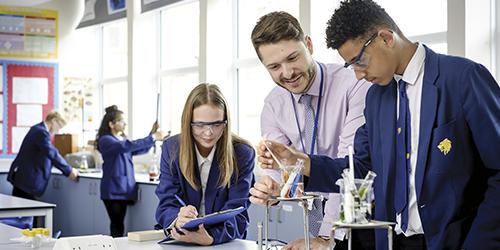In a groundbreaking study that sheds light on the interconnectedness of education, researchers have found that integrating science instruction with reading lessons can significantly enhance learning outcomes for students. The study, featured in the Statesville Record, highlights the dual benefits of this interdisciplinary approach, suggesting that teaching these subjects side by side not only improves comprehension in each area but also fosters a deeper understanding of complex concepts. As educators seek innovative strategies to engage students and boost academic performance, these findings could reshape the way curricula are developed in classrooms nationwide. This article delves into the key insights from the study and explores its implications for educators and students alike.
Benefits of Integrated Learning Approaches in Science and Reading Education
The integration of science and reading education presents a multifaceted approach that enhances student engagement and academic achievement. By intertwining these two disciplines, teachers can create a rich learning environment where students not only comprehend scientific concepts but also develop their reading skills. Some of the notable benefits include:
- Improved Critical Thinking: Students learn to analyze texts and scientific data simultaneously, fostering a deeper understanding of both areas.
- Increased Retention: When students apply reading skills in the context of science, they are more likely to retain information, thanks to the interconnected nature of the subjects.
- Engagement Through Inquiry: Integrated approaches often involve hands-on experiments that encourage students to read for information, enhancing their enthusiasm for both science and literacy.
Furthermore, the benefits extend beyond individual student performance, positively impacting classroom dynamics. Teachers report that integrated lessons stimulate collaboration and discussion among students, creating a more interactive learning experience. This synergy can yield long-term advantages, such as:
| Advantage | Description |
|---|---|
| Enhanced Collaboration | Students work together on projects that require both scientific inquiry and reading comprehension. |
| Holistic Development | Fosters well-rounded learners who can navigate multiple disciplines simultaneously. |
| Better Assessment Outcomes | Students often perform better on assessments that combine elements of both fields. |
Strategies for Effective Implementation of Dual-Content Teaching Methods
To successfully adopt dual-content teaching methods, educators must focus on integrating science and reading seamlessly within the curriculum. An effective approach is to design lesson plans that intertwine scientific concepts with literary materials. This strategy not only enhances comprehension skills but also promotes critical thinking. Key tactics include:
- Using science-themed books that inspire curiosity and discussion
- Incorporating hands-on science experiments that require reading comprehension for procedural understanding
- Utilizing graphic organizers to map connections between texts and scientific principles
Another essential strategy involves ongoing professional development for teachers to foster collaboration and exchange innovative practices. Professional learning communities can be established to share resources and discuss effective methodologies that have shown promise in dual instruction. Implementing observation and feedback sessions can refine these practices, ensuring educators remain engaged and empowered. Highlighted initiatives may include:
| Initiative | Description |
|---|---|
| Peer Observations | Teachers observe each other’s classes to identify best practices. |
| Workshops | Regular sessions focused on dual-content strategies and resources. |
| Resource Sharing | Creation of a shared digital library of materials and lesson plans. |
Enhancing Student Engagement and Comprehension through Interdisciplinary Practices
Recent research highlighted the significant advantages of integrating science and reading in the classroom, suggesting a transformative approach to education. By blending these two disciplines, educators can foster an environment where students engage with content on multiple levels, leading to enhanced understanding and retention. This interdisciplinary strategy not only captivates the interest of young learners but also equips them with critical thinking skills essential for navigating an increasingly complex world.
Key benefits of this integrated approach include:
- Improved Comprehension: By contextualizing reading within scientific themes, students grasp concepts more readily.
- Increased Retention: Engagement in hands-on experiments bolsters memory and connection to the subject matter.
- Skill Development: Students refine their analytical skills as they learn to interpret complex texts alongside scientific principles.
- Collaborative Learning: Interdisciplinary projects promote teamwork and communication, fostering a sense of community in the classroom.
To further illustrate this point, one school successfully implemented a combined curriculum focusing on environmental science and literature. The following table outlines their approach:
| Activity | Subject Focus | Learning Outcome |
|---|---|---|
| Field Trip to Local Park | Science/Reading | Understanding ecosystems while enhancing observational skills. |
| Book Study on Environmental Themes | Reading | Cultivating empathy and awareness about ecological issues. |
| Group Project on Renewable Energy | Science | Applying knowledge in a real-world context to solve problems. |
Key Takeaways
the recent study highlighting the dual benefits of integrating science and reading instruction marks a significant advancement in educational strategies. As educators and policymakers consider ways to enhance student learning outcomes, this research underscores the importance of a holistic approach to teaching that enriches both literacy and scientific understanding. By fostering connections between disciplines, we can cultivate a generation of critical thinkers and informed citizens. As schools in Statesville and beyond look to implement these findings, the potential for improved educational practices could very well transform the learning landscape for students across the nation. As we continue to evolve our teaching methodologies, the focus on interrelated subjects like science and reading could pave the way for a brighter future in education.
